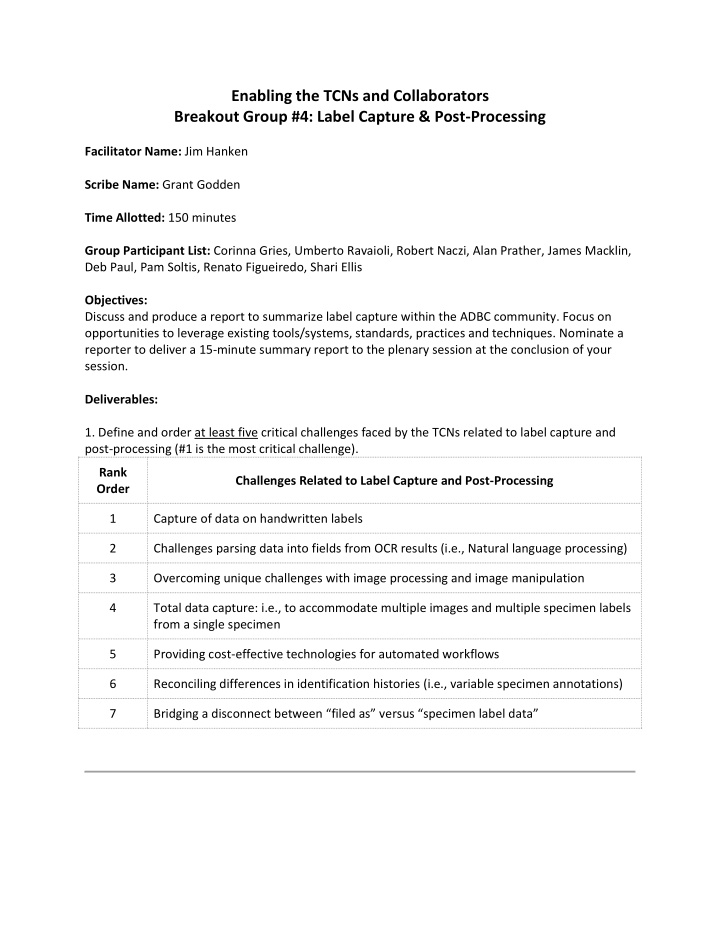



Enabling the TCNs and Collaborators Breakout Group #4: Label Capture & Post-Processing Facilitator Name: Jim Hanken Scribe Name: Grant Godden Time Allotted: 150 minutes Group Participant List: Corinna Gries, Umberto Ravaioli, Robert Naczi, Alan Prather, James Macklin, Deb Paul, Pam Soltis, Renato Figueiredo, Shari Ellis Objectives: Discuss and produce a report to summarize label capture within the ADBC community. Focus on opportunities to leverage existing tools/systems, standards, practices and techniques. Nominate a reporter to deliver a 15-minute summary report to the plenary session at the conclusion of your session. Deliverables: 1. Define and order at least five critical challenges faced by the TCNs related to label capture and post-processing (#1 is the most critical challenge). Rank Challenges Related to Label Capture and Post-Processing Order 1 Capture of data on handwritten labels 2 Challenges parsing data into fields from OCR results (i.e., Natural language processing) 3 Overcoming unique challenges with image processing and image manipulation 4 Total data capture: i.e., to accommodate multiple images and multiple specimen labels from a single specimen 5 Providing cost-effective technologies for automated workflows 6 Reconciling differences in identification histories (i.e., variable specimen annotations) 7 Bridging a disconnect between “filed as” versus “specimen label data”
2. Identify and order up to five existing practices and techniques that can be leveraged for label capture and post-processing (#1 is the most preferred practice/technique). If more than five, focus on the five that are currently the most viable, commonplace, and applicable to the needs of the TCNs and collaborators, while keeping a list of all references to existing practices. Rank Label Capture and Post-Processing Practices and Techniques Order 1 Borrow from existing commercial/proprietary software and practices used by industry/government (CAPTCHA) 2 Imaging (pen camera, gigapan, etc.) 3 Image enhancement and manipulation 4 Multi-keying (crowd-sourcing) 3. Identify and order up to five existing standards that can be leveraged for label capture and post- processing. If more than five, focus on the five that are currently the most viable, commonplace, and applicable to the needs of the TCNs and collaborators. Explain the choices. Rank Order Explanation of Label Capture/Processing Standards Selections 1 DARWINCORE/ABCD 2 AUDUBONCORE 3 OGC: Open Geospatial Consortium 4 Controlled taxon name authority (ITIS, CoL, etc.) 5 ISO Standard (Geography) Other (non- Other controlled names (phenology, etc.) prioritized)
4. Identify and order up to five existing tools/systems that can be leveraged for label capture and post-processing (#1 is the most preferred tool/system). If more than five are proposed, focus on the five that are currently the most viable and beneficial to the greatest number of stakeholders. Explain the choices. Link tools/systems to the practices/techniques (identified in Deliverable #2) and standards (identified in Deliverable #3) that each enables or supports. Linked Linked Practices/ Rank Label Capture and Post- Explanation of Standards Techniques Order Processing Tools Selections (Line (Line Numbers) Numbers) 1 APIARY / SALIX 2 Data Management Systems: SYMBIOTA, SPECIFY, BGbase, etc. 3 SGR (Scatter Gather Reconcile) / FP (Filtered Push) 4 GeoLocate; Geomancer 5 ABBYY OCR (commercial); TESSERACT OCR; Adobe OCR 5. Define specific gaps that exist within each of the identified tools/systems (e.g., functionality problems, scalability limitations, availability, licensing issues, cost, lack of standard usage, missing features). Label Capture and Post- Rank Processing Tools Gaps, Issues and Opportunities for Improvement Order (list 1-5 from table above) 1 APIARY / SALIX Licensing for OCR; May work better with proprietary OCR software; Accommodation of handwriting 2 Data Management Systems: Gaps associated with the components SYMBIOTA, SPECIFY, BGbase, etc. 3 SGR (Scatter Gather Reconcile) / Clustering algorithm improvement; Not ready for FP (Filtered Push) deployment (FP) 4 GeoLocate; Geomancer Ability to store and reuse changes 5 ABBYY OCR (commercial); Handwriting; Licensing costs TESSERACT OCR; Adobe OCR
6. Identify the critical implementation date for HUB appliances that would enable/enhance label capture and post-processing based upon TCN project plans. Explain why this date is critical. Critical Implementation Date Explanation (Appliance) TSTB--TTD: 7/1/12 Subcontracts for entomology begin on this date (7/1/12). For botany, their contracts begin 1/1/13. LBCC: ASAP Work is already underway; if it’s not available from HUB, we will have to complete the work ourselves. IN: 1/1/13 Efforts now are concerned with imaging/raw data capture. 7. Produce documentation related to the development/implementation of a label capture and post- processing appliance to serve the needs of the ADBC community. Functional Requirements: Image processing, image management (local storage/management and transfer to HUB) and text processing. Modular components (for some) vs. total “do -it- all” package (for others); Estimated computational resource Storage space -- are label images stored here? requirements (computation, storage, TBD. Requires additional knowledge of how network capacity): appliance will be configured/deployed. Specific items the HUB needs to deliver to Post-processing appliances; packages/workflows -- enable/enhance label capture and post- what will be hosted at TCN vs. what will reside at processing: HUB Image data management mechanism Feedback/tagging mechanism (for OCR) Useful tool: image “segmentation” software Quality assurance/control module Specific items the TCNs needs to deliver to Unique to a TCN: enable/enhance label capture and post- TTD: lightbox -- share best practices processing: Applicable to more than 1 TCN: Best practices for imaging activities
Provide a risk assessment related to this label capture and post-processing appliance. Likelihood of Occurrence: 1 = Highly Likely, 2 = Somewhat Likely, 3 = Not Likely Impact of Occurrence: 1 = Significant Impact, 2 = Moderate Impact, 3 = Little/No Impact Likelihood of Impact of Potential Mitigation Risk Name Brief Description Occurrence Occurrence Strategies Data error Incorrect data capture by 1 1-3 controlled OCR vocabularies; post- processing curation (e.g., crowd-sourcing, etc.) Destructive From handling 2 1-3 training modules; imaging oversight; best practices Data loss e.g., corruption during file 2-3 1-3 “versioning”; backup processing/transfer (redundant storage) Data integrity Lack of adherence to 1 1-3 Best practices, standards or best standards, versioning practices; Verbatim vs. Interpretation metadata tags Software Software provider goes 1-3 1-3 sustainability out of business or discontinues software 8. Other notes, comments and details not captured elsewhere.
Recommend
More recommend